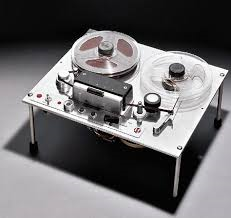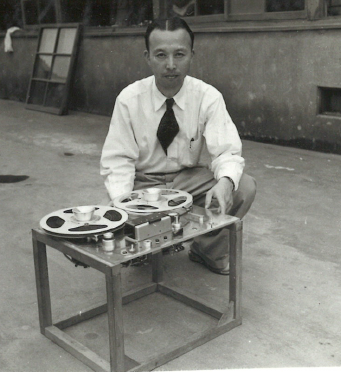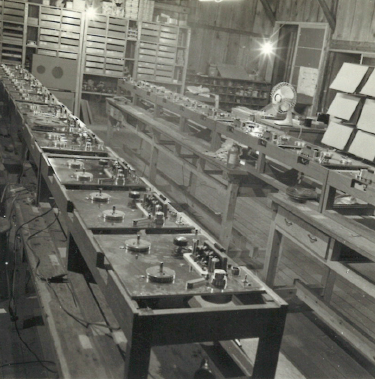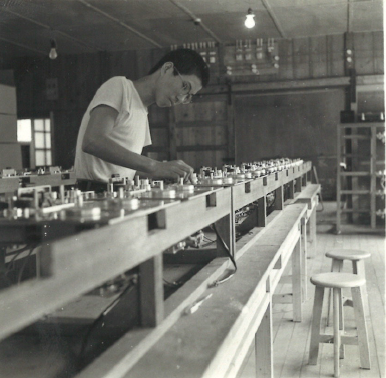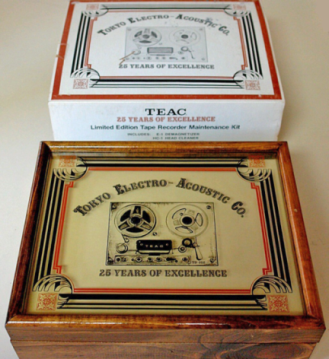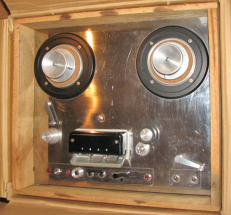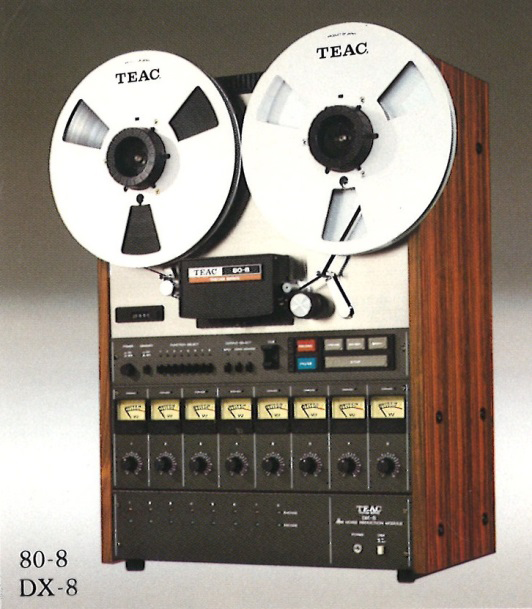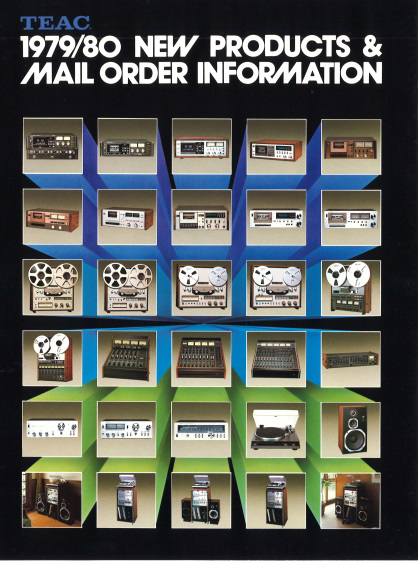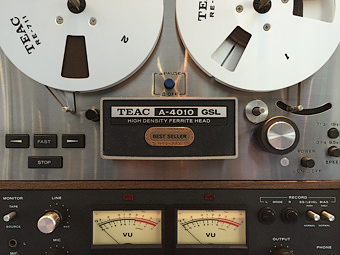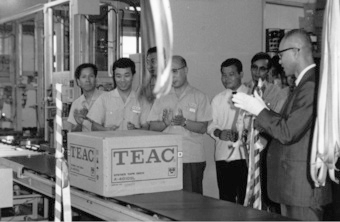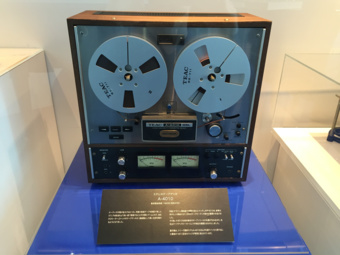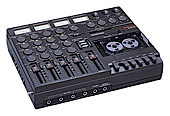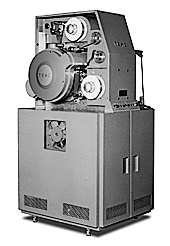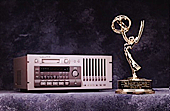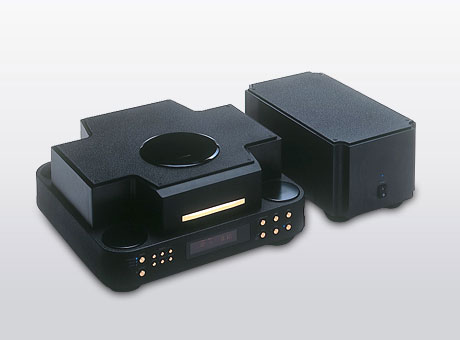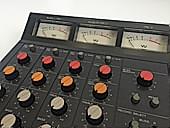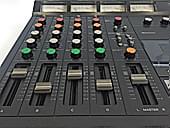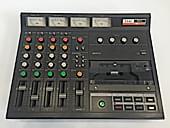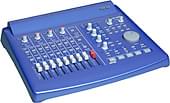TEAC – The History of Sound and Recording
Thank you for your continued support and patronage of TEAC/Tascam. This series will highlight the long illustrious history of our company and products, starting with the first mass produced original TEAC product, the tape recorder TD-102.
TEAC Corporation was originally founded as Tokyo Television Acoustic Company on August 8th, 1953 by two brothers, Katsuma and Tomoma Tani. In 1956 the two brothers founded Tokyo Electronic Acoustic Company, finally merging the two in 1964 to form the modern day TEAC Corporation.
Part 1
The tape recorder from across the sea
For Part 1 of our ‘TEAC – The history of great sound’ series, we would like to introduce TEAC’s first mass produced original product, the TD-102.
In 1957, two Americans came to visit the newly established Tokyo Electronic Acoustic Company at their modest factory. They were the CEO and the chief engineer of a big radio manufacturer called Lafayette Radio Electronics. When Tani showed them the prototype for the TD-102, they said “Add a playback amp, turn it into a tape player and change the casing it to a cabinet and we’ll take it!”. And with that, they ordered 25 units. While happy to receive such a great bulk order, there wasn’t anyone at the company at the time to configure the amps so according to legend, staff had to work flat out for 72 hours straight to complete the order in time. But their hard work paid off, and the TD-102 crossed over into the American market and quickly became a favorite amongst audio fans, thus introducing TEAC’s technology to the outside world for the first time.
However, even after that first big order from Lafayette, few new orders came through. At the time, the extremely high price of a TD-102 (60,000 yen in a time when the starting salary of a graduate bank clerk was 15,000 yen) coupled with the fact that vinyl records were the standard of the day, meant that TEAC was slightly too far ahead of the curve that would one day see tape as the default playback and recording format.
TEAC had a rough start from the beginning, but they had a little help from some saviours from overseas.
Part 2
Sowing the seed for expansion
In April 1958, an engineer from the radio manufacturing firm, Philco called Bretz heard about the TD-102 and came to visit the factory. After exclaiming, “You’ve got such amazing products! Why don’t you tell anyone about them?”, Bretz invited TEAC to perform a demonstration of their products at the Far East Audio Club that he managed on the Tachikawa military base. So TEAC brought 50 TD-102 units to demonstrate and in the end they were all bought with cash on the spot. Tani said later,
“It was so busy at the factory after that, there would be foreign cars parked outside the shabby factory in Sumida day after day, paying in advance for the TD-102. Mr Bretz really was like a God of Fortune for TEAC. He taught us what it meant to do business. He also gave TEAC a vote of confidence for overseas buyers, sewing the seed for future overseas expansion.”
After the TD-102’s initial success, TEAC’s open-reel tape decks gained wide commercial notoriety when an influential American consumer magazine, Consumer Reports, listed it as no. 5 out of 17 tried and tested audio products. When Tani heard this he said “No matter how difficult it is, if you make a technically superior product, it will gain recognition”. It was this strength of conviction that formed the backbone of TEAC’s mission statement “It is from our ability to produce the best products in the world that we derive our reason for being”
Today is the Japan Audio Society’s designated ‘Great Sound Day.’ To celebrate this, we took 2 weeks to introduce TEAC’s very first mass-produced audio product. We hope you enjoyed hearing about it! Don’t miss next week’s installment!
– From ‘The Development of Magnetic Recording in Japan’ [Dokyumento Nihon no Jiki Kiroku Kaihatsu – Oodio to Bideo ni kaketa otoko tachi], DIAMOND Publishing, 1984 –
Part 3
Tascam’s 80-8: The 8 track tape recorder spreading sound across the galaxy
It is December 2015: The long awaited continuation of the Star Wars saga, Star Wars: Episode VII – The Force Awakens, will be in cinemas next Friday. But did you know that the Tascam 80-8 tape deck was used to record the voices of R2-D2 and C-3PO in the making of the first Star Wars movie, A New Hope, in 1977?
The Tascam 80-8 was an 8-track ½-inch reel-to-reel tape recorder, a big hit with professionals at the time, with an easily accessible front panel design allowing all controls to be adjusted on the recorder unit.
When Star Wars was released in 1977, there were life-size R2-D2 promotional cardboard cutouts in all movie theatres, stating that all voice and sound effects were recorded on Tascam equipment. However, due to the film’s instant success, within a week of release adoring fans had stolen all of them! The Tascam 80-8 was also used by many famous recording musicians of the 70s, such as Boston and Kansas.
We’re really excited to see the gang reunited in the new Star Wars movie next week! May the force be with you!
– Tascam 30 years of recording evolution, Randy Alberts; Hal Leonard Corp, (2003) –
Part 4
TEAC A-4010 – A tape deck for everybody
In the 1960s, the average household could enjoy music using various different formats, in line with the technological booms of record players, radio and then tape.
TEAC’s A-4010 was a 4 track tape deck that matched American interior design while being robust and easy to operate for a price that the average family could afford, according to it’s designers at the time. This consumer-driven concept helped the A-4010 to gain popularity and sell over 200,000 units, becoming one of TEAC’s best selling products, as well as signaling the beginning of the audio tape era.
Subsequent open-reel tape decks, such as the A-6010, helped to secure TEAC’s position as one of the best tape deck makers in the world.
At the TEAC HQ in Tokyo, the very last A-4010 series model produced is on display at the entrance, with a special commemorative badge. If you are ever in Tokyo, come and check it out!
Part 5
Lady Gaga’s favourite Christmas present: The Portastudio series, first released in 1979
The ever enigmatic, multi-faceted Lady Gaga, whose talents extend from music and performance to ground-breaking fashion said, in answer to the question ‘What’s the best Christmas present you’ve ever had?’, in an interview in December 2009 on the Ellen Show.
“My Father bought me a 4-track Tascam recorder when I was about 11 years old, and it was this really, really simple mechanism, that I could just sit at the piano and hook up a mic and record by myself, that’s probably the best gift that my Dad ever gave me”.
Watch the Ellen interview here (external link to Youtube)
Part 6
Slow motion Video Tape Recorder
This year (2016) Rio de Janeiro will host the first summer Olympic Games ever to be held in South America. Japan also had a world first with the Tokyo Games in 1964, the first Olympic Games to be held in Asia, and TEAC Corporation was at the helm of those legendary games with technological innovations that still resonate today.
The Tokyo Olympics pushed television sports viewing to new heights with all-new slow-motion VTR, overseas satellite feed, color broadcasts and live broadcast of the full marathon course. They called it the “Television Olympics”. Today’s vibrant sporting coverage would be incomplete without slo mo shots, and we owe all this to NHK’s broadcast technology department and TEAC corporation, who jointly developed this groundbreaking new technology.
The technology first used over 50 years ago is still bringing the joy of sport into people’s homes today. We look forward to seeing what the athletes have to offer at this year’s Games!
Part 7
How do you practice music?
How do you practice music? Do you use sheet music and a practice book, or listen to your favorite tracks over and over until you can replicate them? In the old days, you had to listen to a record until the vinyl wore down and wouldn’t play anymore!
In 2003 Tascam released a world-first* CD trainer perfect for guitar practice, the CD-GT1. It included groundbreaking features such as the ability to the key or change the tempo of a track during playback without changing the original notes. It also had a tuner, metronome and various effectors. This made it really easy to memorise super-fast guitar riffs by slowing them down without distortion.
Tascam still make great music trainers today. As well as for guitar we have bass and vocal trainers too. They’re the perfect companion for musicians wanting to nail that solo. Check them out here https://tascam.eu/en/downloads/cd-gt2
*according to internal research
Part 8
Tascam and the Emmy Awards
The Emmy Awards are given in recognition of a significant contribution to the American broadcasting industry. Tascam has played an integral role in broadcasting not only in Japan but also in America, and for this we have had the honor of being awarded two Emmy Awards for our digital multi-track recorders.
The first award was for the DA-88 in 1995. The DA-88 is an 8 track digital multi-track recorder that uses Hi8 video cassette tapes. Its low running costs and the ability to connect up to 16 machines together simultaneously made it a vital new addition to broadcast recording systems.
The transport on the DA-88 is the same as the one used on NASA space shuttles. NASA was shocked by the fact that it could survive a 9g impact, exclaiming “My God we only needed to be able to salvage the data from it – we didn’t expect it to still work!”
Then in 2000, the multi-track recorder and player MMR-8 and MMP-16 won a second Emmy Award. An Academy press release stated at the time, “The MMR-8/MMP-16 and DA-88 are two of the very few such audio offerings to ever win this award. Tascam is literally the only pro audio equipment manufacturer in the world to have ever won an Emmy twice within such a narrow time frame.”
Source: Tascam, 30 years of recording evolution, Randy Alberts; Hal Leonard Corp, (2003).
Part 9
ESOTERIC P-0
In 1987, TEAC’s persistent technological endeavors in the audio field gave rise to a new high-end audio brand: ESOTERIC. 10 years after ESOTERIC was founded, they released the P-0 CD transporter.
ESOTERIC channeled all the technical know-how they had amassed over those first 10 years to produce the P-0. It was said at the time that “CD software can bring out hidden sounds that were hitherto unknown”. With that in mind, the P-0 was the first CD player to be equipped with a unique "Lossless Sled", an optical pickup mechanism providing extremely accurate data retrieval, which at the time made it the highest spec CD player available.*
ESOTERIC is also famous for its VRDS mega system**, which is used in not only the P-0, but TEAC’s VRDS-50 and TASCAM’s broadcast CD player, CD-701.
ESOTERIC continue to strive to deliver “The joy of the highest levels of musical elation”.
* At the time of release in 1997, according to internal research
** VRDS (Vibration-Free Rigid Disc-Clamping System). For a detailed explanation, please
see:
https://www.esoteric.jp/en/technology/vrds_neo
https://www.esoteric.jp/en/product/d1/top
Part 10
TEAC 144
In 1979, TEAC released the world’s first* standard cassette tape 4-track portable multitrack recorder. The 144 was high quality, compact, easy to use and at a price that the average musician could afford. Billboard’s Pro Sound News magazine called it the most revolutionary audio product to hit the marketplace.
The 144 gave many musicians the chance to make their own music for the first time, making a huge contribution to the world of popular music. Bruce Springsteen famously recorded his 1982 album Nebraska at home on his TEAC 144.
Continuing in the vein of the original 144, the Portastudio series is still loved by musicians to this day:
*At the time of release, September 1979, according to internal research
Part 11
TEAC WX-7000 (at JAXA)
Did you know that TEAC contributes to the exploration of space?
JAXA, The Japan Aerospace Exploration Agency, uses the TEAC WX-7000 Wideband Data Recorder for analyzing engine vibrations as part of their cutting-edge rocket propulsion development program. The WX-7000 can record up to 128 channels, and combined with its reliable backup system is the perfect choice for the JAXA research and development team.
We at TEAC are proud to say the TEAC WX-7000 truly has a key role in contributing to mankind’s space exploration.
See here for a case study of TEAC WX-7000 at JAXA:
https://datarecorder.jp/en/products/wx-7000/case.html
You can find out more about JAXA here:
https://global.jaxa.jp
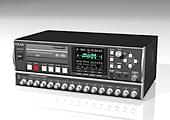
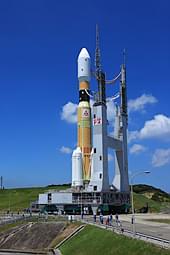
Part 12
TASCAM US-428
In 2000, Tascam released the ground-breaking USB audio interface, US-428. At the time, most audio interfaces and MIDIs used a DAW to control them via a PCI card. The unique thing about the US-428 was that it combined both the DAW controller and USB connection into one machine.
Today, audio interfaces are indispensable in music production, internet broadcast and PC-based sound engineering.
For an overview of the latest Tascam USB audio interfaces, visit this page:
https://tascam.eu/en/category/computer-audio
Part 13
TEAC TD-330
“The earth is blue, how wonderful. It is amazing.” were the famous words of Russian Cosmonaut Yuri Gagarin, but do you know the call sign of the first woman in space, Valentina Tereshkova? She said “It is I, Seagull”.
In 1957, when the world’s first artificial satellite, Sputnik 1 was blasted into space, the Soviet Radio wave research department needed to receive radio waves broadcast from space so they ordered TEAC tape recorders. TEAC sent five TD-330 recorders, and for the next 10 years recorded satellite signals for the American and soviet space programs.
On June 16th 1963, Valentina Tereshkova became the first woman to travel into space
aboard the Vostok 6.
Her
call sign of “Seagull” was the first thing she relayed back to base with the
confirmation “I am
Seagull”
(Ya Chaika, Ya Chaika).
The TEAC TD-330 was the first to catch it and transmit Tereshkova’s voice to the world.
Sources: Nihon Kougyo Shimbun; “Those who face the challenge”, November 18th 1969, January 15th 1970; Hachiro Ota.
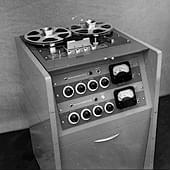
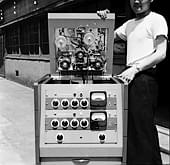
Page last modified: 2023-04-26 09:17:23 UTC
